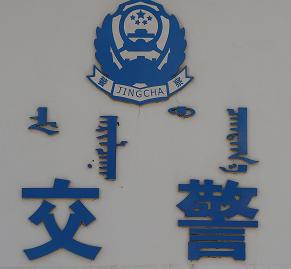| |
| SMHRIC |
|
Dec 2, 2007 |
| New York |
|
 |
|
|
"Traffic Police", a sign found in Huhhot, capital of
IMAR. Three out of the four Mongolian words are
written incorrectly.
|
|
 |
|
|
Five out of six Mongolian
words are written incorrectly. (Sign from Huhhot) |
|
|
|
|
 |
|
|
Four out of five Mongolian
words are incorrect. (Sign from Huhhot) |
|
 |
|
|
None of the three Mongolian
words is correct. (Sign from Huhhot) |
|
 |
|
|
None of the two Mongolian
words is correct. (Sign from Huhhot) |
|
According to one of China’s state controlled official presses,
Inner Mongolia News Net (www.nmgnews.com),
the 31st Meeting of the 10th People’s
Congress of Inner Mongolia Autonomous Region (IMAR) spent a half
day on November 29, 2007 to discuss issues related to the
implementation of the “Regulation of Inner Mongolia Autonomous
Region Mongolian Language Work” which was passed by the 12th
Meeting of the 10th People’s Congress of IMAR on
November 26, 2004.
The
report says, during the evaluation of the implementation, many
discussion group members admitted that serious problems exist
with the implementation of the regulation:
“Mongolian language translation departments of the Party
Committee and government branches have sharply reduced in number
and dramatically dropped in capacity. There are only 6
translation units with a total number of 23 full-time
translators; the number of students studying in Mongolian and
the number of people using Mongolian language have rapidly
declined; the number of students learning in Mongolian has
dropped from 380,000 in 1986 to 240,000 at present; the number
of Mongolian Language Textbooks for elementary school first
grade has been reduced from 68,600 books in 1992 to 22,500 in
2006, being reduced by 2/3 in 15 years; the number of copies of
‘Inner Mongolia Daily’ printed in Mongolian has dropped from
13,800 copies to 6,000 today.”
Recommendations made at the Meeting include:
“Urging
the government leaders to pay close attention to these issues
and come up with a detailed implementation plan, focusing on the
promotion of Mongolian teaching as a major nationality
education, improving the schooling condition of nationality
education; Enhancing the teacher’s workforce and improving the
educational quality; Re-arranging the existing curriculum;
Increasing job opportunities for students who learned in
Mongolian.”
China has
always claimed that the Mongols in the region enjoy freedom and
prosperity similar to other citizens of the country. In August,
Yang Jing, governor of the Inner Mongolia Autonomous Region,
said during the celebration of 60th anniversary of
the Autonomous Region that “Mongolian culture has never
flourished as it does today and the Mongolian language has never
been used as widely as it is now.” In response to this claim, an
ethnic Mongolian cyber dissident nicknamed Bayaguud writes in
his article entitled “The Discussion Regarding Mongolian
Language Issues in Response to Governor Yang’s Interview with
Correspondents”, asking Yang Jing “as the Chairman of the
People’s Government of Inner Mongolia Autonomous Region, where
and when did you use Mongolian language in your speeches even
once? Have you ever published a single article in any Mongolian
language publication? Which public occasion did you speak
Mongolian? Is there a single government branch that uses
Mongolian language as the language of administration and
governance?” Bayaguud continues, “if answers are no, how can you
say a language is widely used in a region where even the
governor doesn’t use it?”
|





